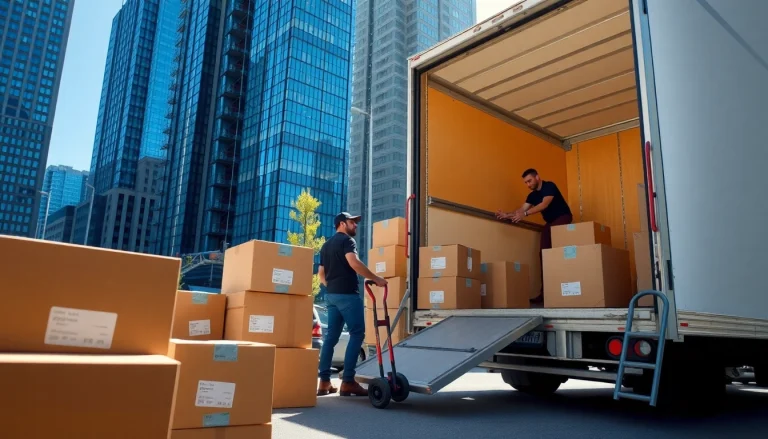Understanding House Moves: What You Need to Know
Defining House Moves
A house move refers to the process of relocating from one residence to another. This transition can be driven by various factors, such as a new job, family dynamics, or simply a desire for a change in scenery. Regardless of the reason behind it, the essence of house moves is rooted in the practical aspects of packing up belongings, transporting them to a new location, and settling into a new home. Understanding what house moves entail is the first step toward ensuring a smooth transition.
Types of House Moves
There are several types of house moves that individuals and families may face:
- Local Moves: These involve moving within the same city or town. Local moves are typically defined by their short distances, often within a radius of 50 miles.
- Long-Distance Moves: Any move that exceeds the local distance threshold falls into this category. Long-distance moves often require more planning, coordination, and resources.
- International Moves: Moving to another country entails more complex logistics, including customs clearance, international shipping, and sometimes even visa considerations.
- Commercial Moves: Companies relocating their offices or storefronts face different challenges compared to residential moves, often needing to minimize downtime and coordinate with multiple stakeholders.
Planning Your House Move
Effective planning is crucial for minimizing stress during house moves. Begin by establishing a timeline that outlines key steps to complete before, during, and after the move. This should include notifying utility companies, updating your address, and organizing logistics with your movers. The earlier you start planning, the easier the entire process will be.
Step-by-Step Guide to Preparing for a House Move
Creating a Moving Checklist
A moving checklist serves as a roadmap throughout your transition. It should cover various tasks, categorized by timelines, and can include:
- Two months before the move: Start decluttering, research moving companies, and gather packing supplies.
- One month before the move: Confirm your moving date, begin packing non-essential items, and inform your landlord or real estate agent if necessary.
- One week before the move: Finalize the packing of all items, double-check your utility disconnections, and pack a moving essentials box.
- Moving day: Ensure pets are secured, direct the movers, and perform a final walkthrough of your old home.
Choosing the Right Moving Services
When it comes to house moves, selecting the right moving service can significantly impact the outcome of your transition. Here are some factors to consider:
- Movers vs. DIY: Decide whether hiring professionals or handling the move yourself aligns with your budget and capabilities.
- Check Reviews: Research local moving companies by checking their ratings, reading customer testimonials, and ensuring they are licensed and insured.
- Request Quotes: Get multiple quotes to compare prices and services offered. Ensure that these quotes are comprehensive, outlining all potential costs.
Packing Tips for a Successful Move
Packing is one of the most daunting tasks during a house move. Here are some practical packing tips to streamline the process:
- Start Early: Begin packing as soon as you’ve confirmed your moving date to avoid a last-minute rush.
- Label Everything: Use clear labels for each box, indicating its contents and the room it belongs to in your new home.
- Protect Fragile Items: Use bubble wrap, packing peanuts, and sturdy boxes for fragile items to prevent breakage during transport.
Best Practices for Executing House Moves Smoothly
Coordinating with Movers
Effective coordination with your moving team can lead to a more efficient move. Communicate your expectations clearly and provide them with necessary access to your old and new homes. This includes any specific instructions regarding delicate items or difficult-to-navigate spaces.
Safety Tips During the Move
Moving day can be hectic, but prioritizing safety is vital. Follow these tips to reduce the risk of injury:
- Lift Properly: Bend your knees and keep your back straight when lifting heavy boxes to avoid strain.
- Stay Hydrated: Keep fluids handy to stay hydrated, especially if moving in warm weather.
- Avoid Clutter: Ensure walkways are clear of obstacles, facilitating safe movement throughout your space.
How to Manage Moving Day
Moving day can be overwhelming, but with proper management, it can go smoothly. Consider the following:
- Stick to Your Checklist: Keep your checklist handy to ensure all tasks are being completed.
- Delegate Tasks: Assign specific responsibilities to family members or friends who are helping you, alleviating the workload.
- Take Breaks: Schedule short breaks to recharge. It’s essential to stay energized throughout the day.
Common Challenges in House Moves and How to Overcome Them
Dealing with Last-Minute Changes
Last-minute changes can arise, causing stress. Remain adaptable and keep open lines of communication with your moving company. If plans change, reassess your checklist and adjust accordingly, prioritizing what now needs immediate attention.
Managing Stress During a House Move
House moves can provoke anxiety due to their multifaceted nature. Here are techniques to manage stress effectively:
- Practice Deep Breathing: Take a few moments for deep breathing exercises to calm your mind.
- Stay Organized: Having a structured plan and checklist will mitigate uncertainty and help you feel in control.
- Reach Out for Support: Don’t hesitate to ask friends or family for help or emotional support when needed.
Budgeting for Unexpected Expenses
Even the best-laid plans can encounter financial surprises. Allocate a buffer in your moving budget to manage unexpected costs like last-minute packing supplies or damage during the move. Keeping track of all expenses closely can help ensure you remain within your financial constraints.
Post-Move Considerations: Making Your New House a Home
Unpacking Efficiently
After the move is complete, unpacking becomes the next challenge. Tackle this systematically by prioritizing rooms, starting with the essentials. A helpful tip is to focus on one room at a time, unpacking as thoroughly as possible before moving on to the next.
Setting Up Utilities and Services
A well-functioning home requires utilities and services. Ensure all essential services—such as electricity, water, and internet—are set up prior to your move-in date. Contact utility companies ahead of time to schedule installations and confirmations.
Tips for Settling into Your New Neighborhood
Once you’ve moved, take proactive steps to integrate into your new community:
- Explore Local Amenities: Visit nearby parks, grocery stores, and recreational facilities to familiarize yourself with your new surroundings.
- Engage with Neighbors: Introduce yourself to neighbors and join community events to build relationships.
- Stay Connected: Use social media platforms or local forums to stay updated on community activities and news.
In conclusion, successful house moves require thorough planning, organization, and effective management of resources and relationships. By applying these strategies, you can ensure that your transition to a new home is as seamless and stress-free as possible. For more information on how to facilitate house moves, consider consulting with removal specialists who can guide you through the process.








